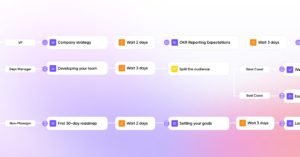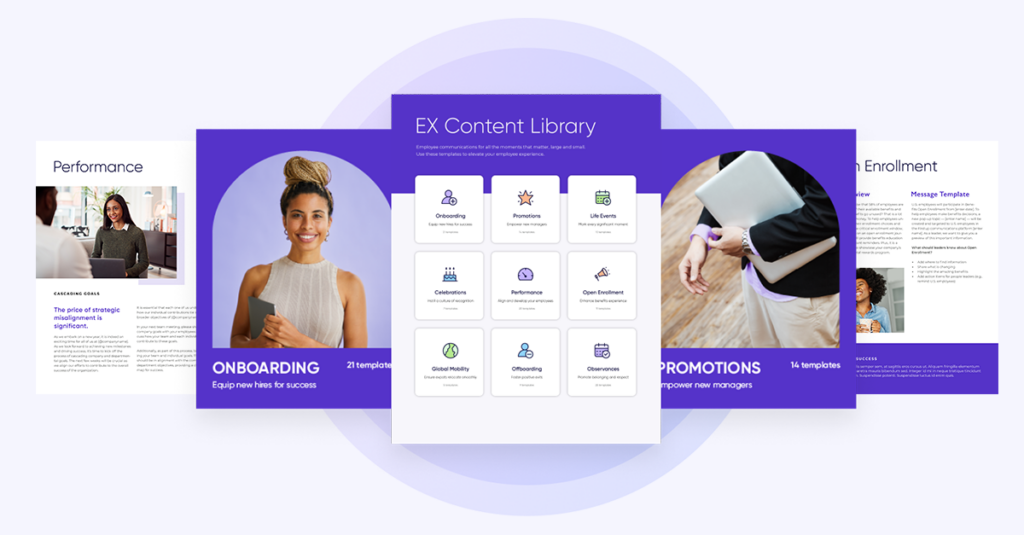Successful HR leaders understand that when new employees are guided through a positive onboarding strategy, it not only saves time and money for HR teams but also better prepares employees to do their job well and become valued coworkers and assets for the company. Here’s how to do it right.
What is onboarding?
Employee onboarding is the process by which a company’s HR department introduces and integrates new hires into an organization, getting them up to speed with everything they need to know to do their job after they accept a job offer.
During an onboarding process, a new employee should learn about company culture, review the employee handbook and policies, meet managers and other employees, complete new hire paperwork, learn more about what their day-to-day job responsibilities will be, get their equipment set up, and generally start to get acclimated to their work environment.
Because the first experience an employee has with an organization is an onboarding process, and because it can be a long and arduous process, it’s vital that HR professionals and leaders work through this process efficiently and productively. When done correctly, it’s been shown that there is an 82% increase in the likelihood of a new hire staying on board and succeeding with the company. On the other hand, when ineffective, studies have found that 68% of new hires leave their jobs after just 3 months.
Onboarding can be expensive…
The average US employer spends $4,000 and 24 days to hire a new employee, so we can see just how important a positive onboarding experience is to both the new employee as well as the company’s bottom line, in terms of retaining workers and saving money on constant recruiting and hiring efforts.
…but doesn’t have to be
Benefits of successful onboarding
While it can often take weeks or even months to complete, an effective onboarding process has the potential to set up your employees for success while lowering your recruiting costs, benefiting both parties at the same time. But beyond the basics, there are a lot more benefits to successfully onboarding new hires, some of which you may not have even considered. Let’s take a look.
Increased productivity
Did you know that 77% of new employees who went through a formal onboarding process were able to meet their first performance goals?
Onboarding does more than just introduce a new hire to the company; it also sets them up for success. They learn about the job duties, where materials are, who they will work with, and what’s expected of them, including the key performance indicators they will be measured by.
Improved employee morale
An organization’s culture, including its onboarding program, plays an important role in employee satisfaction and morale. If new team members feel left out, haven’t met any new colleagues, or wondering what they are supposed to be doing every day, they are going to have a negative view of the company – and act accordingly. Involving new hires right away improves morale and makes for a better employee experience.

Higher retention rates
We noted earlier that studies have found that 68% of new hires leave their jobs after just a few months if the onboarding program isn’t effective, but if you give new employees clear expectations and the tools they need to do their job, not only will they benefit greatly, but so will the company. After all, Gallup estimates that the cost of replacing an employee who leaves is one-half to two times their annual salary.
Employee retention rates affect the corporate bottom line nearly as much as the general cost of doing business!
Better employee engagement
We have written before about how employee engagement is key to company success because it is one of the most important indicators in gauging work satisfaction. And when new hires have a positive onboarding experience, they are more likely to be enthusiastic about the organization they work for.
A recent Global Human Capital Trends survey found that 79% of respondents stated that a sense of belonging in the workforce was important to them, and 93% agreed that a sense of belonging drives organizational performance.
Engaged employees are more productive, more dedicated to their employer, and take pride in what they do.
Promotes communication
An effective employee onboarding process promotes communication between employees and leaders by breaking down the walls typically found at corporations. New hires, when onboarded correctly by the HR team, interact with many different employees and other departments, setting them up to have conversations with them on an ongoing basis.

Attracts top talent
Your new hires will talk to their friends and others about their new job, your onboarding process, their work environment, company culture, and their employee experience; that’s a fact. And when they have good things to say about all of it, your company will benefit from internal referrals and word getting out on the street about how you conduct your business.
Make sure what new employees tell others is positive by following best practices for onboarding!
Reduced stress
A positive onboarding program helps to alleviate stress by providing employees with all the information and tools they need to do their job effectively. Learning everything they can about the company helps them to better understand not only their role but also the company culture and policies necessary to be successful in their new position.

Employee mental health and wellbeing is an important topic in today’s working world, so doing everything you can to lower stress levels – especially during first-week onboarding, when confusion can run rampant – goes a long way toward not only job satisfaction but the entire employee experience, too.
Employee onboarding vs. employee orientation
Often confused, but never the same – employee onboarding and employee orientation. One is part of the other, and both are very important to meeting the goals of the new employee and the company alike.
Employee onboarding
Employee onboarding is generally a series of events, to-dos, and training that helps get new hires up to speed at the company, and can take weeks or months to complete. It is part of an overall plan to work with new employees to understand their job better, learn expectations, and begin projects.
The focus of onboarding is the employee’s role in their department or job.
Employee orientation
Employee orientation is part of the onboarding process and is the part of it that involves new hires doing paperwork, getting an office tour (if applicable), meeting coworkers and getting introduced, signing up for benefits, etc. It is more general-purpose than onboarding, and employee orientation usually lasts a few days to about a week.
The focus of orientation is the employee’s overall role and inclusion at the company.
Importance of developing a clear onboarding process
While we already covered the benefits of onboarding, here’s why HR leaders should have a clear employee onboarding process in place before bringing in a new hire:
- It’s an employee’s first experience with the company
- You never get another chance to make a first impression
- Sets the tone for what to expect at your company
- Validates the new employee’s decision
- Helps employees feel appreciated and welcome
- Helps new hires understand how to navigate their new workplace and job descriptions
- Establishes team member relationships with leaders and colleagues
- Keeps managers accountable
- Helps new employees with relationship building
- Demonstrates the value of the company’s mission
- Reduces the expenses associated with high turnover rates
- Ensures workplace policy compliance from day one
- Analytics and metrics help guide an organization’s need to make changes to the process
- Maintains a competitive advantage over other companies in hiring new talent

Onboarding best practices
Your new employees will be bombarded with information on their first week of work; it’s best to follow some best practices in your employee onboarding process to ensure they aren’t both overwhelmed and unsure they made the right decision to join your organization.
Here are some best practices to pay attention to when onboarding new employees:
- Start the employee onboarding process before the first day
- Get as much paperwork done as you can, right away
- Assemble a welcome package to send to new hires
- Ensure there is a consistent process that can be repeated and improved
- Explain opportunities for growth and job-specific training
- Establish a common set of resources and company policies
- Set up new equipment in advance, at least as much as possible
- Keep in mind what it was like when you first started
- Help new employees make friends and meet direct managers
- Ensure the process feels personal and addresses individual needs, especially for remote employees, vital for employee engagement
- Send out a new employee announcement to team members
- Get buy-in from leadership on your employee onboarding process
- Collect feedback from new employees during the hiring process
- Utilize a new hire checklist to ensure you don’t miss any steps while employee onboarding!
Get our free guide, The ultimate onboarding checklist for the comms-driven HR leader!
FAQ
While it’s been reported that 58% of organizations say their onboarding program is focused only on processes and paperwork and oftentimes only lasts a month or so, HR leaders say that onboarding should be an ongoing process that should last 90 to 100 days.
A new hire onboarding checklist provides a way for hiring managers to stay organized and on track when guiding new hires at their organization. Download The ultimate onboarding checklist for the comms-driven HR leader to get you started.
By tracking analytics garnered during your onboarding process, and watching statistics on things like employee retention rates, you will quickly be able to judge whether your efforts are working or if you need to make some changes.
Analyze, our unified analytics dashboard, shows you how all of your employees are interacting with all of your content and whether your business initiatives are working—on every channel and system, across your organization.
Instead of just burying your new hire in paperwork and tedious reading, and leaving them to fend for themselves, spend some time developing a new employee onboarding process that covers all the bases. No one wants to show up for work on the first day, and not know what to do!
Yes! While not every aspect of it can be, it’s been shown that organizations with somewhat automated onboarding processes result in higher employee retention rates, because new hires don’t feel as overwhelmed by everything they have to do/accomplish during their first week. The Firstup intelligent communication platform can help you automate and standardize your onboarding workflow across all departments and save time for your HR team.
Because companies can experience a 50% failure rate in retaining new hires if the onboarding is bad, it’s important that leadership makes it interesting and engaging, if not outright kinda fun. Some of the ways to do this include scheduling a team lunch on day one, sending a welcome package of company swag, or playing a get-to-know-you game like “Two Truths and a Lie” to break the ice.
Along with trying to make the onboarding process a little more interesting, there are some other things you can do to make an employee’s first day memorable. Why not greet them in person (if possible), send a personal welcome email, have them meet the CEO, make time for a team and manager lunch, and follow up with them at the end of the day to answer any questions they may have? Remember, they are walking into a brand new situation, and the more comfortable you can make them, the better their first day will be.
You may have heard of the “5 C’s” for onboarding, but do you know what they are? They are
compliance, clarification, culture, connection, and checking back.
Compliance makes sure that your new hire has read and understands the company policies.
Clarification lays out the expectations around job performance and how an employee’s role fits into the company mission.
Culture demonstrates the company’s values, mission, history, and long-term vision.
Connection ensures that new employees are introduced to buddies, mentors, and relevant teams and leaders in your organization.
Checking back means that HR leaders continue to connect with new hires on a regular basis, making sure they are assimilating into the organization.
Conclusion
After receiving an offer letter and accepting a position, an employee’s experience with the onboarding process sets the tone for how their work life will be. How HR handles this process affects not only the new employee but also the company itself, as engaged and happy employees tend to stay at companies longer.
Many job seekers are watching potential employers, and their friends who go work for them, to see how onboarding goes (and how long the new employee stays) before deciding to apply for open positions. Make sure your company has an onboarding process in place that checks all the boxes and has all the details necessary to meet the needs of the new hire and the organization and makes a good first (and lasting) impression with new employees.
Many of the organizations we work with agree that onboarding can be an arduous process to manage due to information overload and a lack of goals, process, feedback, and most importantly, a complete lack of personalization.
With the Firstup intelligent communication platform, we make it easy to automatically connect new hires to important resources, inspiring welcome messages, and crucial compliance training.
Download PDF








